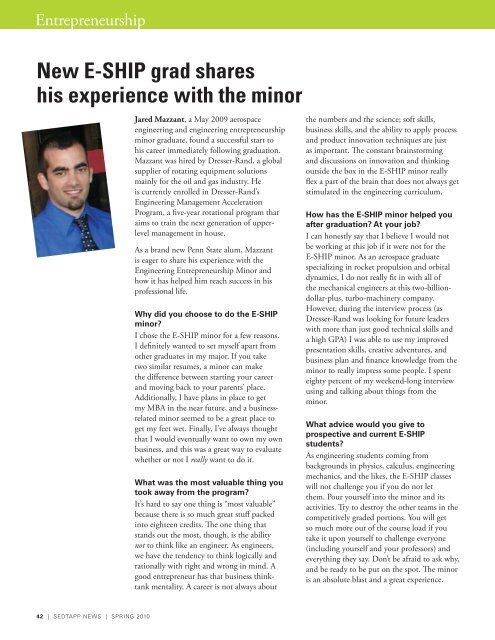Download the PDF - School of Engineering Design, Technology ...
Download the PDF - School of Engineering Design, Technology ...
Download the PDF - School of Engineering Design, Technology ...
You also want an ePaper? Increase the reach of your titles
YUMPU automatically turns print PDFs into web optimized ePapers that Google loves.
EntrepreneurshipNew E-SHIP grad shareshis experience with <strong>the</strong> minorJared Mazzant, a May 2009 aerospaceengineering and engineering entrepreneurshipminor graduate, found a successful start tohis career immediately following graduation.Mazzant was hired by Dresser-Rand, a globalsupplier <strong>of</strong> rotating equipment solutionsmainly for <strong>the</strong> oil and gas industry. Heis currently enrolled in Dresser-Rand’s<strong>Engineering</strong> Management AccelerationProgram, a five-year rotational program thataims to train <strong>the</strong> next generation <strong>of</strong> upperlevelmanagement in house.As a brand new Penn State alum, Mazzantis eager to share his experience with <strong>the</strong><strong>Engineering</strong> Entrepreneurship Minor andhow it has helped him reach success in hispr<strong>of</strong>essional life.Why did you choose to do <strong>the</strong> E-SHIPminor?I chose <strong>the</strong> E-SHIP minor for a few reasons.I definitely wanted to set myself apart fromo<strong>the</strong>r graduates in my major. If you taketwo similar resumes, a minor can make<strong>the</strong> difference between starting your careerand moving back to your parents’ place.Additionally, I have plans in place to getmy MBA in <strong>the</strong> near future, and a businessrelatedminor seemed to be a great place toget my feet wet. Finally, I’ve always thoughtthat I would eventually want to own my ownbusiness, and this was a great way to evaluatewhe<strong>the</strong>r or not I really want to do it.What was <strong>the</strong> most valuable thing youtook away from <strong>the</strong> program?It’s hard to say one thing is “most valuable”because <strong>the</strong>re is so much great stuff packedinto eighteen credits. The one thing thatstands out <strong>the</strong> most, though, is <strong>the</strong> abilitynot to think like an engineer. As engineers,we have <strong>the</strong> tendency to think logically andrationally with right and wrong in mind. Agood entrepreneur has that business thinktankmentality. A career is not always about<strong>the</strong> numbers and <strong>the</strong> science; s<strong>of</strong>t skills,business skills, and <strong>the</strong> ability to apply processand product innovation techniques are justas important. The constant brainstormingand discussions on innovation and thinkingoutside <strong>the</strong> box in <strong>the</strong> E-SHIP minor reallyflex a part <strong>of</strong> <strong>the</strong> brain that does not always getstimulated in <strong>the</strong> engineering curriculum.How has <strong>the</strong> E-SHIP minor helped youafter graduation? At your job?I can honestly say that I believe I would notbe working at this job if it were not for <strong>the</strong>E-SHIP minor. As an aerospace graduatespecializing in rocket propulsion and orbitaldynamics, I do not really fit in with all <strong>of</strong><strong>the</strong> mechanical engineers at this two-billiondollar-plus,turbo-machinery company.However, during <strong>the</strong> interview process (asDresser-Rand was looking for future leaderswith more than just good technical skills anda high GPA) I was able to use my improvedpresentation skills, creative adventures, andbusiness plan and finance knowledge from <strong>the</strong>minor to really impress some people. I spenteighty percent <strong>of</strong> my weekend-long interviewusing and talking about things from <strong>the</strong>minor.What advice would you give toprospective and current E-SHIPstudents?As engineering students coming frombackgrounds in physics, calculus, engineeringmechanics, and <strong>the</strong> likes, <strong>the</strong> E-SHIP classeswill not challenge you if you do not let<strong>the</strong>m. Pour yourself into <strong>the</strong> minor and itsactivities. Try to destroy <strong>the</strong> o<strong>the</strong>r teams in <strong>the</strong>competitively graded portions. You will getso much more out <strong>of</strong> <strong>the</strong> course load if youtake it upon yourself to challenge everyone(including yourself and your pr<strong>of</strong>essors) andeverything <strong>the</strong>y say. Don’t be afraid to ask why,and be ready to be put on <strong>the</strong> spot. The minoris an absolute blast and a great experience.East AfricaTwo international opportunities incorporatingengineering design, humanitarian engineering, andengineering entrepreneurship exist in Africa. SeniorResearch Associate and <strong>Engineering</strong> <strong>Design</strong> InstructorKhanjan Mehta leads two semester-long projects withan additional three-week trip to East Africa in earlysummer.The first project, Mashavu: Networked HealthSolutions for <strong>the</strong> Developing World (www.mashavu.com), is a humanitarian design and socialentrepreneurial venture in East Africa. Mashavuenables medical pr<strong>of</strong>essionals around <strong>the</strong> worldto connect with patients in <strong>the</strong> developing worldusing modern technology and communicationsinfrastructure. Trained operators at Mashavu stationsin developing communities collect essential medicalinformation from patients on a regular basis. Webservers aggregate this information from variousMashavu stations over a cell phone link and provideit on a Web-based portal. Medical pr<strong>of</strong>essionalscan view <strong>the</strong> patient’s information and respondto <strong>the</strong> patient and <strong>the</strong> nearest doctor(s) with <strong>the</strong>irrecommendations. Students participate in this projectthrough EDSGN 452 Projects in Community Service<strong>Engineering</strong> or EDSGN 497C <strong>Design</strong> <strong>of</strong> DevelopingCommunities.The second project, WishVast: Building Trust andSocial Capital Using Cell Phones, is a cell phone-based social networking platform that harnesses <strong>the</strong>pervasiveness <strong>of</strong> cell phones in African countriesto build trust, optimize resource utilization andsupply chains, connect people and expand <strong>the</strong>irsocial networks, facilitate peer-to-peer trade, andhelp people emerge from poverty. The WishVastteam works with a diverse set <strong>of</strong> non-governmentalorganizations and governmental and industrypartners in East Africa to test <strong>the</strong> system and identify<strong>the</strong> best application scenarios and revenue models tocommercialize WishVast. Students participate in thisproject through EDSGN 452 Projects in CommunityService <strong>Engineering</strong> or EDSGN 497C <strong>Design</strong> <strong>of</strong>Developing Communities.For more information and for ways to get involvedwith <strong>the</strong>se projects, contact Khanjan Mehta atkhanjan@engr.psu.eduI N T E r N a T I O N a L P r O g r a M s42 | SEDTAPP NEwS | SPriNg 2010 SPriNg 2010 | SEDTAPP NEwS | 43




